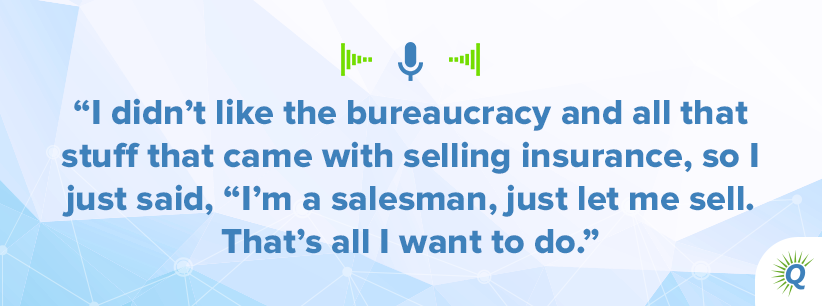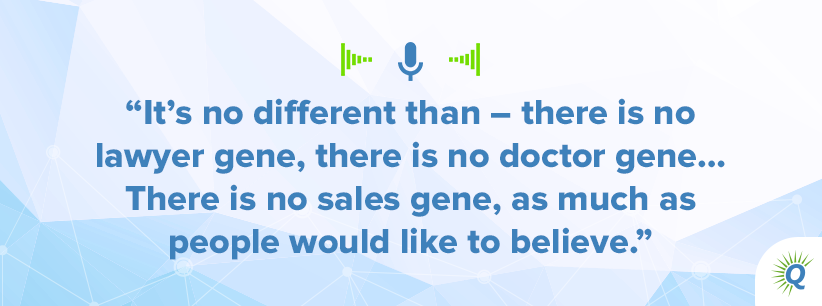Topics:
Never Miss a Beat - Get Updates Direct to Your Inbox
FILTER:


5 Steps to Design a Better Sales Process [for SaaS]
By Chris Moore
If you want to add value to a SaaS business, one of the first places to look is your sales process. Ali Mirza has seen it all and knows sales inside and out. He advises that every sales process can be improved if you know where to start, when to start, and how to go about selling smarter not harder. Here’s an inside look at the steps he takes to optimize a sales team and maximize the value of either a SaaS business for sale or your existing business.
Step #1: Start in the right place at the right time
If you’re an early-stage company, when do you begin building?
Step #2: Bend but don’t break – offer the right level of flexibility
Step #3: Strike the right balance between product-knowledge vs. product-positioning
Step #4: Build customer success into the sales process
Step #5: Measure the right type of performance
I sold cars once. For eight days. And made $4,000.
All in all, not a bad return for time spent back then.
They weren’t just cars. They were beautiful cars – an elegant combination of engineering and art.
I loved driving them and gazing at them. I loved the way they were built.
But there was one tiny problem…I was a really bad salesperson. Really bad.
The $4,000 was dumb luck.


Listen to the Source of this Post:
This blog post is based on a podcast episode that we recently recorded. Listen to the full episode here:Looking back, I think my terrible sales skills mostly boiled down to an attention problem.
The cars held my attention. And the interesting variety of people who wanted to drive the cars held my attention.
But whether or not one of the people actually purchased one of the cars?
Not that interesting after all. After a week, it felt like I was trapped in a cheap amusement park with very expensive rides.
I decided then and there that I was a born not-salesperson.
When Ali Mirza says that salespeople aren’t born at all, but are made with the right processes, I have to wonder if it’s just because he hasn’t met me yet.


But Mirza would know, he’s been in sales since he was 19 years old.
He quickly became the number one sales rep in the country at his first company. Then started his own hired-gun sales consulting firm, Rose Garden, 8 years ago.
Now he’s designing sales processes for SaaS and other service-based companies and teaching sales teams to work smarter and make a lot more money.
Which really comes in handy because one of the first places to look if you want to add value to an existing business or you’re evaluating a SaaS business for sale should be its sales processes. Mark calls it low hanging fruit.
With sales, you’re getting your hands directly on revenue levers like cost of customer acquisition and conversion rates, even churn.
Make the right adjustments, especially in a business with recurring revenue, and the value of a business can skyrocket.


At Rose Garden, for instance, results they’ve produced include a 2x increase of the average deal size in just one month.
And in another instance, an increase in ARR (Annual Recurring Revenue) from $5MM to $12MM.
Looking at a SaaS business for sale? Want results like that? Let’s look at the 5 steps Ali recommends for a SaaS business owner who wants to grow revenues quickly by fine-tuning their sales process.
Step #1: Start in the right place at the right time
The bad news if your sales results are lagging?
You’re probably not going to get lucky and have the solution to the problem walk through the door or answer your LinkedIn job posting.
According to Ali, those mythical “rock star” salespeople that every company hopes to find are extremely rare.


First of all, he says, rock stars aren’t born that way, they’ve been trained. They may have been born with an outgoing personality, but that’s not enough to execute consistently and get stellar results.
And a trained salesperson who’s hitting all the right marks isn’t likely to be wandering around searching for a job. Too indispensable.
“Good salespeople are golden-handcuffed in,” Ali says, so good luck hiring them.
Enter great sales processes.
So where to begin?
Ali advises that while every business is unique, you must always start in the same place.
Start with “who.”
Who’s buying what you have to sell?
The sales process should be custom tailored to that person, and often, as with any good marketing campaign, it’s critical to break down your customer base into segments.


At Rose Garden they begin by understanding those segments, who you’re selling to, and evaluating the process you already have in place.
Are you selling in the right way to the right people and at the right price?
Ali and his team take a day on site to assess the situation with the goal of finding out three things:
- What you’re doing right and should keep doing.
- Everything you’re doing wrong that needs to change.
- Everything you’re not doing but should be.
They’re looking to answer all the basic but essential questions about your customers and your current sales process:
- Who’s buying?
- What are they buying?
- Why are they buying?
- How are they buying?
Ali gives as an example an online education platform that sells to both large organizations and individual freelancers.
The company had one sales process for all their customers but needed to distinguish between what worked for the large-organization customers and what worked for the smaller customers.


Their assessment revealed that by tying up a salesperson’s time with the small-customer segment, the company was paying a steep opportunity cost.
They rearranged the process, took that segment off the sales team’s plate, and increased revenues with a seemingly simple adjustment.
If you’re an early-stage company, when do you begin building?
“A sales process is not something that you build once, and that’s it,” Ali says, “It’s a living, breathing document that’s constantly being iterated.”
“But,” he points out, “you need a foundation to start.”
Once you acquire a SaaS business for sale, there’s no time like the present, but for a founder it’s a different story.
Ali has a process for building that sales foundation for a new SaaS company.
- First, you sell yourself as the founder of the company.
- After you sell to a few customers yourself, you hire two salespeople. This generates healthy competition, but also collaboration. Your first two salespeople will feed off each other and learn from one another, Ali says.
- Then, after the first two people have proven the concept, that’s when you systematize and document your steps and tactics. Develop a well-defined sales process before you hire your 3rd and 4th salespeople and more, so that you’re offering guidance and keeping costs down.
Again, the process is not set in stone, but it gives new team members a place to start, gets them through the first 18 months or so, and keeps new hires from burning through potentially valuable prospects and draining your profits.


Step #2: Bend but don’t break – offer the right level of flexibility
When asked how much latitude to build into your sales process, Ali answers straight up, “a lot.”
All employees need parameters within which they operate, but even so, “I’m not looking to handcuff and put my salespeople in a straight jacket,” he says.
When looking at a SaaS business for sale, it’s something to look out for…have clear expectations been set for salespeople? Are they too restrictive?
Nobody wants to be a salesperson bound by an overly rigid process and reading from a fake-sounding script.
But as a business owner, you do want to ensure that over the course of that first 18 months, your new salesperson has paid for him/herself. For that, he or she will need a system to follow.
After that, well-trained salespeople need the flexibility to be themselves and use the muscles they’ve built up with time and experience.
Loosen the reins
Ali says the problem if you try to rein everyone in too tightly is this…
The same part of the brain that finds the path of least resistance and closes the deal, will also find ways over and around your rigid parameters and seek out the path of least resistance to their highest commission.
A good analogy is this… when a horse gets tired of you pulling on its mouth, he’ll take the bit between his teeth and take off on his own. Then you better hold on.


In other words, an inflexible process will inevitably have salespeople go rogue and cut corners to make their own lives easier.
And that sets you up for the disaster that nobody talks about but almost everyone’s been through… a salesperson goes out the door, and your revenues go with them.
Like the work of a shoddy seamstress, all their deals slowly come apart at the seams after they leave.
You avoid that disaster with well-defined but appropriately flexible processes.
And you work with your salespeople’s strengths and not against them by giving them room to breathe.
Step #3: Strike the right balance between product-knowledge vs. product-positioning
Ali is a firm believer in the importance of subtext.
When asked how much product-related expertise a salesperson needs, Ali answers carefully.
It’s great for them to have as much knowledge as possible about the product, but they don’t need to use it in every case.
Like they say, a hammer isn’t the right tool for every job.
Or as Ali puts it, knowledge is ammunition, and you don’t go using a tank to kill a mosquito.


The most important thing to teach your salespeople, according to Ali, is not just what the product does, but how to position it.
Again, subtext is everything. That means the understanding that begins to dawn on the prospect as you ask the right questions, the theme that begins to emerge for them as the sales process unfolds, and the emotion underlying that theme…
Those things sell the product, not your recitation of its features.
It’s a subtle distinction, because I’m guessing that the more you know your product’s functionality, the more compelling the subtext and the better you’ll sell.
On the other hand, Ali might say the more you understand and get to know your prospect, the better you’ll sell.
Despite being a horrible salesperson, I can relate to this point. Remember my dumb-luck commission?
That couple really wanted to buy the car; I just took the time to find out why.
When looking at a SaaS business for sale, there may be a huge opportunity for you if the current sales process focuses more on what the product does and less on the best way to position it.


Step #4: Build customer success into the sales process
Mark asked an important question on last week’s podcast…how best to avoid that disconnect between the people who sell the product/service and the people who build it.
It often leads to over-promising and under-delivering when enthusiastic salespeople expound on features that actually only exist in the developers’ dreams.
Which then leads to lots of apologizing and an overburdened customer-service team.
Does Ali have any tricks of the trade to help avoid that?
Yep. You build the sales process from back to front.
At Rose Garden, his team starts with customer success, interviews customers to find out what their actual experience with the product looks and sounds like, and works back from there to the pitch.
Then, the solution to the over-enthusiasm problem, which Ali says sometimes starts with the founder, lies in a carefully built and custom-tailored process.
And the proper training on what customers actually experience after the deal is done to set very realistic expectations for your salespeople.


Step #5: Measure the right type of performance
Find a great SaaS business for sale, and one of the first things you want to do it look for opportunities to optimize.
Of course, if you can’t measure it, you can’t optimize it.
When it comes to measuring the success of your sales process, Ali is careful to distinguish between quantitative data (like all the variables of a conversion rate calculation, for instance) and qualitative data (like actual conversations) for decision making purposes.
His advice… do not ignore the qualitative side.
In other words, “you gotta listen to the calls” in order to diagnose issues that may need to be addressed and iterate to get better. Spending time with your salespeople will provide invaluable information.
“Quantitative will only tell you what you’re prepared to understand,” Ali points out, “and what you’re prepared to understand is filled in by the Qualitative.”
He’s adamant that data can’t tell you everything you need to know about how well your sales process is performing in real time. Are there issues around price, was it too easy to close, too hard?
A qualitative study tells you those things and those things in turn explain the numbers.
It sounds like an intricate dance to me. Which has me thinking of Epic Games’ Fortnite – arguably home to the best (or worst if you have kids) automated sales processes of all time backing a revenue generating machine.


When Fortnite launched on the iPhone in April, the app reportedly brought in $2MM a day. Not a typo.
I’m guessing it’s not quantitative data alone that helps them design their customer journeys – that produced the genius idea for an income stream like “emotes,” for instance (the dance moves players can purchase to celebrate wins).
More likely, their insanely profitable tactics and offers come from watching players play the game and following the sales process as it unfolds with actual users in real time.
Clearly the developers at Epic Games understand and would agree with Ali on the importance of subtext, and their use of it is flawless.
One of the many things I was probably missing in my shortest-ever sales career.
Sometimes it’s all about an outside perspective.
Meanwhile, something tells me if you’re a SaaS business owner, with a seasoned expert like Ali taking a look at your sales processes, you won’t be missing much.





